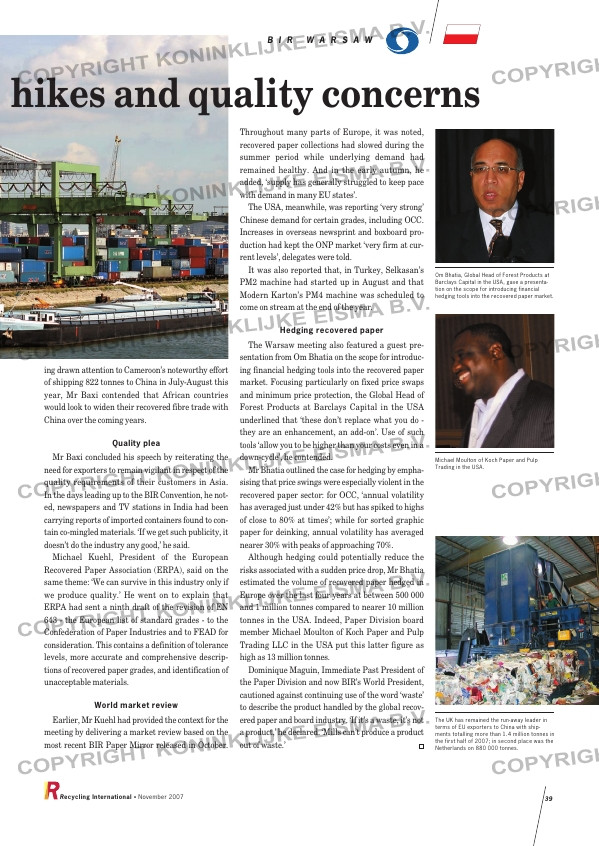Page 39 from: November 2007

ing drawn attention to Cameroon’s noteworthy effort
of shipping 822 tonnes to China in July-August this
year, Mr Baxi contended that African countries
would look to widen their recovered fibre trade with
China over the coming years.
Quality plea
Mr Baxi concluded his speech by reiterating the
need for exporters to remain vigilant in respect of the
quality requirements of their customers in Asia.
In the days leading up to the BIR Convention, he not-
ed, newspapers and TV stations in India had been
carrying reports of imported containers found to con-
tain co-mingled materials. ‘If we get such publicity, it
doesn’t do the industry any good,’ he said.
Michael Kuehl, President of the European
Recovered Paper Association (ERPA), said on the
same theme: ‘We can survive in this industry only if
we produce quality.’ He went on to explain that
ERPA had sent a ninth draft of the revision of EN
643 – the European list of standard grades – to the
Confederation of Paper Industries and to FEAD for
consideration. This contains a definition of tolerance
levels, more accurate and comprehensive descrip-
tions of recovered paper grades, and identification of
unacceptable materials.
World market review
Earlier, Mr Kuehl had provided the context for the
meeting by delivering a market review based on the
most recent BIR Paper Mirror released in October.
Throughout many parts of Europe, it was noted,
recovered paper collections had slowed during the
summer period while underlying demand had
remained healthy. And in the early autumn, he
added, ‘supply has generally struggled to keep pace
with demand in many EU states’.
The USA, meanwhile, was reporting ‘very strong’
Chinese demand for certain grades, including OCC.
Increases in overseas newsprint and boxboard pro-
duction had kept the ONP market ‘very firm at cur-
rent levels’, delegates were told.
It was also reported that, in Turkey, Selkasan’s
PM2 machine had started up in August and that
Modern Karton’s PM4 machine was scheduled to
come on stream at the end of the year.
Hedging recovered paper
The Warsaw meeting also featured a guest pre-
sentation from Om Bhatia on the scope for introduc-
ing financial hedging tools into the recovered paper
market. Focusing particularly on fixed price swaps
and minimum price protection, the Global Head of
Forest Products at Barclays Capital in the USA
underlined that ‘these don’t replace what you do –
they are an enhancement, an add-on’. Use of such
tools ‘allow you to be higher than your costs even in a
down-cycle’, he contended.
Mr Bhatia outlined the case for hedging by empha-
sising that price swings were especially violent in the
recovered paper sector: for OCC, ‘annual volatility
has averaged just under 42% but has spiked to highs
of close to 80% at times’; while for sorted graphic
paper for deinking, annual volatility has averaged
nearer 30% with peaks of approaching 70%.
Although hedging could potentially reduce the
risks associated with a sudden price drop, Mr Bhatia
estimated the volume of recovered paper hedged in
Europe over the last four years at between 500 000
and 1 million tonnes compared to nearer 10 million
tonnes in the USA. Indeed, Paper Division board
member Michael Moulton of Koch Paper and Pulp
Trading LLC in the USA put this latter figure as
high as 13 million tonnes.
Dominique Maguin, Immediate Past President of
the Paper Division and now BIR’s World President,
cautioned against continuing use of the word ‘waste’
to describe the product handled by the global recov-
ered paper and board industry. ‘If it’s a waste, it’s not
a product,’ he declared. ‘Mills can’t produce a product
out of waste.’
Recycling International • November 2007 39
Om Bhatia, Global Head of Forest Products at
Barclays Capital in the USA, gave a presenta-
tion on the scope for introducing financial
hedging tools into the recovered paper market.
Michael Moulton of Koch Paper and Pulp
Trading in the USA.
The UK has remained the run-away leader in
terms of EU exporters to China with ship-
ments totalling more than 1.4 million tonnes in
the first half of 2007; in second place was the
Netherlands on 880 000 tonnes.
ht hikes and quality concerns
B I R W A R S A W
RI_038 BIR-Paper:Opmaak 1 08-11-2007 16:14 Pagina 39



